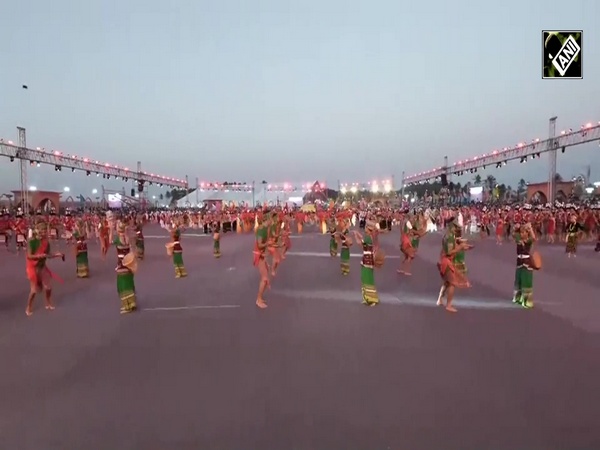China's encroachment tactics near Bhutan ring alarm bells in neighbouring countries
Sep 02, 2022

Beijing [China], September 2 : China's aggressive attitude towards its territorial disputes has cautioned many of the neighbours of its cheap tactics to derail years of negotiations to attain leverage over countries, through the means of economic, political or even territorial encroachments.
In line with China's disputes with other countries, Bhutan is another neighbour, where China has tried to widen its territorial claims to gain strategic advantages.
Over the years, China has been gradually and stealthily invading its tiny neighbour Bhutan. It has tried to pressurize Bhutan to cede some of its most crucial territories in both its eastern and western frontiers.
China claims over 764 km of Bhutan's territory, which includes Doklam, Sinchulung, Dramana and Shakhatoe in the northwestern region and the Pasamlung and Jakarlung Valleys in the central part of Bhutan.
Bhutan, a small Himalayan landlocked nation, shares a massive 470 km long border with China and is one of the only border nations, which China does not share its diplomatic relations with.
Until 2021, both the countries had signed two treaties in an attempt to resolve their border disputes in 1988 and 1998, yet to little effect. Discussions on border resolutions have been ongoing between the two nations since 1984, with around 24 rounds of talks and at least 10 expert group meetings that had been held since then, The Singapore Post reported.
However, these discussions had seemed to bear little fruit for 37 years until a new road map agreement was forged in October 2021.
The 'Roadmap for Expediating the Bhutan - China Boundary Negotiations' was an MoU that was signed in October last year between both nations after a break of five years in border negotiations due to the Doklam crisis and the Covid pandemic.
The Chinese side in a step to resolve their boundary dispute specifically with Bhutan signed this 3-step road map that laid down the process for speeding up the demarcation of territory negotiation talks.
Bhutan's border dispute with the Chinese is largely focused on two separate areas of land.
This dispute has historically also included the India-China-Bhutan tri-junction area of Doklam which measured up to 270 sq. km; the very same area that saw a 70-day stand-off between the two nuclear-powered nation in 2017.
However, the three-step Roadmap between China and Bhutan does not include the tri-junction area, as an understanding in 2012 between India and China stated that any tri-junction dispute will only be resolved with all three countries being involved.
The other border dispute that Bhutan and China seem to face includes the Pasamlung and Jakarlung in northern Bhutan nearing Tibet. In 1997, the Chinese allegedly proposed a 'package deal' to Bhutan in which it was willing to trade off the disputed northern and central parts of Bhutan which included the Pasamlung and Jakarlung valleys in return for its western part including Doklam.
This proposal was henceforth rejected as Bhutan was not willing to give up the land that secured its strategic interests. China on the other hand was clearly targeting the western areas that would bring it strategic advantages with the narrow Chumbi Valley and also give a vantage point over the Siliguri Corridor through Doklam.
China in any case have paid little heed to Bhutan's concern of transgression by building infrastructure on Bhutanese land; this had also invariably caused the Doklam stand-off and was a testimony to Chinese tactics.
In 2020, China, in an attempt to pressurize Bhutan to cede some of its most crucial territories in both its eastern and western frontiers widened its territorial claims by claiming the Sakteng wildlife sanctuary (740 sq km) in the Trashigang region in eastern Bhutan.
China's territorial claim on the Sakteng sanctuary, which is linked and shares a border with Arunachal Pradesh in India is part of that same game plan where the Chinese feel negotiations can be held by exerting external pressures through demented territorial claims adrift of historical context.
In any case, these territorial demarcations that China so desperately wishes to rile up through its three-step roadmap are as farcical as its extended claims on Bhutanese territory; in an attempt to derail negotiations with the Indian side as well as to add leverage into their own positionings, the Chinese have rather unravelled the roadmap to their own method of dealing in such crucial situations.
Excessive overreach on territorial claims is part of that very same strategy that China will deploy in most, if not all of its disputes; the South China sea dispute is an example of such tactics as well, The Singapore Post reported.
China's disagreements with many of its neighbouring countries have subsequently radiated a shadow of apprehension upon the Chinese administration and its foreign policy objectives.
This has also invariably created a series of political, diplomatic and military conflicts with nations that seem to be locked in horns with the Chinese.
The number of territorial disagreements regarding China currently stands at a staggering 17 disputes with its boundary-sharing nations; of which at least 7 seem to be territorial disputes related to land cover.
The Chinese Communist Party has continued its assertive policy toward the neighbouring countries to not only strengthen its position along the frontiers but also gradually cut-off piece by piece the other nation's land.
Given the understanding of China's negotiation tactics, it is important that Chinese strategy be deciphered for what it truly stands to mean, The Singapore Post reported.



















